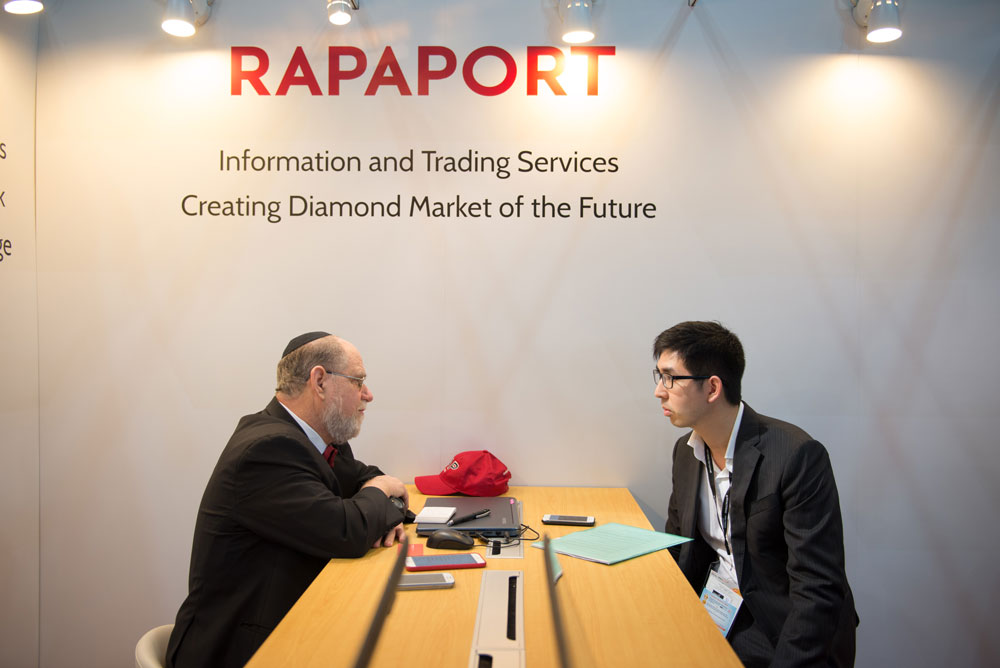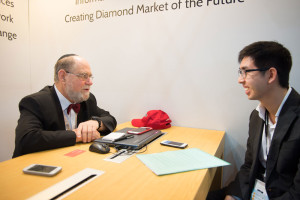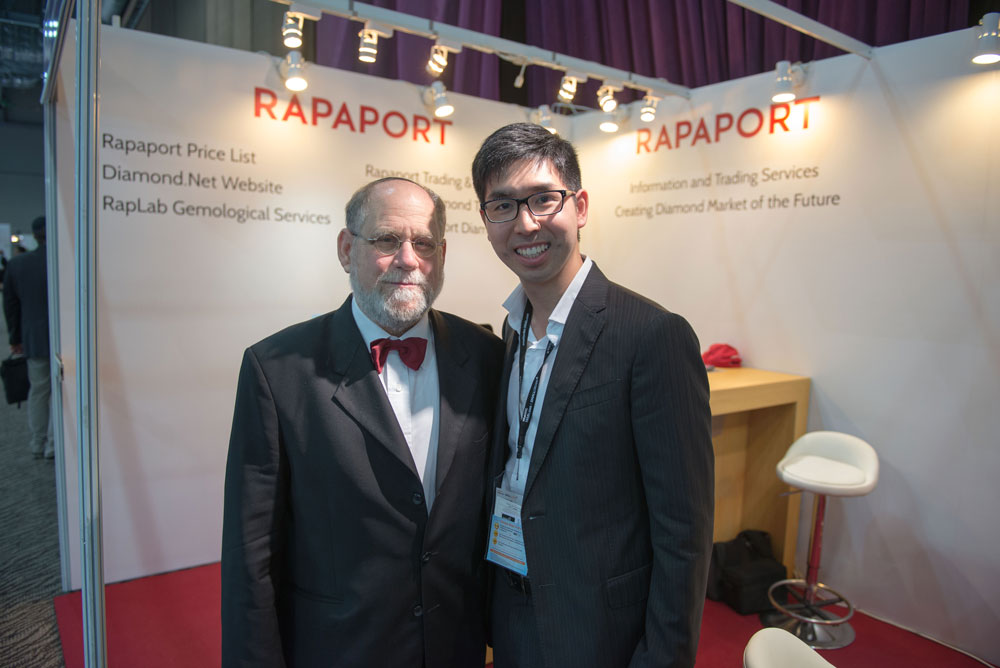 Last Friday wrapped up this year’s Hong Kong International Diamond, Gem, and Pearl Show at the Asia World Expo in Hong Kong. The show is Hong Kong’s largest international jewelry show and attracts many people in the trade to buy and sell diamonds.
Last Friday wrapped up this year’s Hong Kong International Diamond, Gem, and Pearl Show at the Asia World Expo in Hong Kong. The show is Hong Kong’s largest international jewelry show and attracts many people in the trade to buy and sell diamonds.
This year, I was particularly excited because Martin Rapaport had agreed to do an interview with Prosumer Diamonds. The name Rapaport has become synonymous with diamonds and any diamond prosumer will have heard of the Rapaport Price List and perhaps even the RAPnet diamond trading network.
When I first saw Martin he was wearing his signature bow tie and you could say that I was more than a little star struck. His demeanor was very welcoming and he had a lot of interest in what I was doing at Prosumer Diamonds. I asked Martin to give us some of his insights into the diamond industry and to share some advice that he would give to consumers who are looking to purchase a diamond engagement ring.
The diamond industry is undergoing a period of extensive change.
“Rough diamond prices are too high relative to polish so I would expect rough diamond prices to come down.
China, which was a very strong market for the larger stones is now becoming almost non-existent due to the Chinese government policy against conspicuous consumption and all the anti-corruption campaigns so that has affected the big stone market.
The Euro has come to a new low, which is kind of problematic in that is initially causes a drop in demand and eventually it’s going to create an increase in demand as people move to diamond as a stored value rather than the Euro or other questionable currencies.
Then to add insult to injury you have the current situation in the Arab world with oil going to $40-$50 a barrel, which is definitely decimating the wealth effect.
On the positive side, I think that the Chinese market will continue to be very robust for diamonds under the one-carat size.
I think that there will be a good steady demand coming because there is a seven and a half percent growth rate in China. There are a lot of young people getting engaged so I think the diamond engagement ring acquisition rate will be persistent and consistent.
India is becoming once again more of a consumer market rather than a productive center so I’m quite please with the outlook for India as well.
America is a very consistent and steady market, which I think is going to be just fine. With the strength of the dollar, I think America is doing okay and I think it will continue to do okay. I think it’s a good lesson also for the world that we always look at the new kid on the block be it China or India or wherever it is but sometimes we forget our old friends. So America is going to be and will continue to be the most dominant diamond demand center of the world.”
Consumers should be concerned about where they buy their diamonds.
“First of all, I think that you need to know where you’re buying your diamonds from because you might be getting some jewelry manufacturer in China with synthetic diamonds and you don’t know they’re synthetics.
If you’re going to be buying diamonds, you better be dealing with a reputable source and that’s number one. There are a million ways for the consumer to be taken advantage of and it’s important for the consumer to buy from a reputable source even if it cost a little more. So if you’re looking for a total bargain, as we like to say, if you can’t believe how cheap it is, then it probably unbelievable in terms of quality. So be careful, if it appears to be too cheap, it may not be the real thing.
It’s like buying a Rolex for $10 at the night market.”
Diamond investors should be more careful.
“Issues like bank credit will have an impact on diamond prices as liquidity tightens up, so yes I think there’s going to be more reality in diamond prices and diamond markets.
So consumers that are buying diamonds and thinking the only reason why I’m buying a diamond today is not because I’m getting engaged but rather because I’m looking to invest, then they need to be more careful.
We are running our own Rapaport investment group now that is advising people and they should be more careful.
The overall picture is one of good demand because the global demographics is of more and more people becoming consumers or middle class consumers so I think that we will see literally a nearly 80-100 million new middle class consumers emerging in China and India over the next decade per year.
I think that the supply side is not going to grow at the same rate as the demand side, but I don’t think the price appreciation consideration is the most primary factor for a young man getting engaged.”
Diamonds must have legitimacy.
“If this is a gift between a man and a woman to celebrate their love and their relationship, blood diamonds don’t belong in that equation whatsoever and neither does fraud or misrepresentation.
We believe that EGL diamond grading reports uses a different standard than the GIA, but they use GIA terminology. So it’s like if I put an 18-carat gold stamp on and it’s really 14-carat or something. Misrepresentation is unacceptable to us and it is certainly not acceptable in the trading network that we own and operate.
We would of hoped that the World Federation of Diamond Bourses, the International Diamonds Manufacturers Association, and various consumer advocate organizations within countries like in Hong Kong would step up to the plate and say this is not acceptable business practice. They haven’t done so and we are quite disappointed in that.
Misrepresentation of diamond quality by using the terminology of the GIA and another standard is something we will not tolerate so we will be the policemen of the industry to the extent that we are powerful or important to the industry, but again, we don’t control what other people do. We control what goes on in our own network, and our network has to have a high level of not just legal but also ethical responsibility, which touches all issues of ethics.
I think this is something that transcends more than the law, so if you want to play according to the law you could still buy Marange Diamonds, diamonds from Zimbabwe that are involved in humans rights abuses. We will not tolerate those sales in our trading networks. So we take a more value driven, ethically driven approach to the diamond industry in what we do. In India, it’s perfectly legal to trade Zimbabwe Marange diamonds, but we will not trade those things. We will not grade them; we will not work with them; and we believe in doing the right thing.”
A culture of communication has defined the current generation of diamond buyers.
“There’s a huge amount of interaction with information now that never existed before. Which means that companies like Blue Nile or Zbird or whoever it is have a chance to influence the consumer even if people don’t buy there.
Price information, the availability of that information is so available whether it’s air travel, computer supplies, video screens, or diamonds. It has become a cultural capability of the cultural icon.
I read a book a while ago that the consumers of this generation are more like cats than dogs. They don’t respond to the ringing of the bell and here comes the meat. They are not Pavlovian because what they are doing is that everybody is different and they’re looking at their unique space and they’re interested in what makes sense for them. They are not necessarily brought in or bought in by advertising; but a friend’s recommendation, that’s going to have more weight.
We are in a culturally communicative society, which puts a great value on sources of information that are not coming from the sell. And we see that in the travel industry and we will certainly be seeing more and more in this industry.”
The trend is for diamonds to be branded.
“The next generation is moving into the branding story, particularly for diamonds. I don’t think you can buy a watch that doesn’t have some brand on it. It might be an inexpensive Timex watch or it could be a very expensive Patek Philippe, but you can see it in Rolex’s impact on the jewelry industry.
The next generation is going to be very into brands and the message of the brands, and I would say even more than the usual idea behind the product.
Expect a higher level of ethical responsibility from those brands and also for a certain higher level of quality assurance. So consumers don’t mind paying more for a product, but they want to get something. Is a branded diamond worth more than a non-branded diamond? I think yes.
There’s going to be a market of branded jewelry for young couples and for other people and the brand will carry value. So when it’s re-sold or when it’s traded, a person will have something of greater value.”
Buy a diamond online, but ask an expert to look at it.
“As long as it has some return privilege I would definitely consider buying a diamond online.
Asking an expert to look at the diamond is probably a good idea. I would buy diamonds online subject to inspections. I should say this, however, if you do have someone inspecting it for you, for example Rapaport is now introducing a RapLab and we’re examining diamonds for clients, then you can have a high level of assurance if you’re investing or even if you’re a consumer when you’re buying.
There are things that don’t appear on the GIA grading report. I call those TBCE for tinted, black, centered inclusions, or eye-clean, which are generally problems with the SI grades.
These are questions that you’ll have to have someone to look at the diamond for you to ascertain the relationship between the product and the quality. It doesn’t necessary mean you shouldn’t buy a diamond that is not eye-clean, but the price should reflect that. An SI grade doesn’t give you that information.”
New technology will change the way we buy diamonds.
“The next generation is going to be the technologically advanced generation, the generation that is going to see exponential technological growth and change.
I’m talking about glasses that might tell the temperature, or warn you of a meeting, or they might tell you all kinds of things. The clothes that you wear might have all kinds of abilities, the windows in your house will be able to collect energy, cars that can drive themselves, and diamond rings that have RFID tags in them so you’ll never lose them. There are a million and one things that are going to happen.
It’s going to be technology everywhere, in everything. The chair you’re sitting in will know who you are and what height you want to sit at. It’s just using technology to make the world around you more comfortable and smarter. It’s going to be a big boom.”
Comfort is the new king.

So cut is king is wrong but cut is one of the most important factors in a diamond that should always be present so I would advise buying any kind of diamond that is a reasonable color and clarity and I would probably insist on a GIA triple ex. Even if it didn’t have a GIA, I would still want a fine cut, cut is important.
As a consumer, well, first of all you want to make sure that you’re comfortable and the budget is right. So decide how much money you want to spend on a diamond and don’t go crazy spending too much. If you’re not comfortable for any reason; you’re not comfortable with the money, you’re not comfortable with the person you’re dealing with, and you’re not comfortable with the quality of the stone, don’t buy that diamond!
Be very careful with who you’re dealing with. Some people like to sort diamonds; I say sort the people! Find someone you’re comfortable with and trust. Don’t feel you’re under pressure to buy. A lot of times you are under some pressure, you really want to get engaged, but I say relax and find the time to find someone that you trust.
Comfort is king. Sometimes it’s the brand and sometimes it’s the person you know. We have dealers here, people that buy very expensive diamonds from top dealers direct, and they know the guy and the guy knows them and they trust them and they love the guy.”
Check the Internet for pricing.
“You want to look at the Internet and check out competitive prices.
Compare GIA graded diamonds against other GIA diamonds on the Internet. And even if you don’t buy from the Internet supplier, I don’t think I need to tell people this but when people are buying diamonds today, everyone is checking the Internet for everything. I can’t see you buying an airplane ticket without going to Expedia.com and I can’t see you buying a diamond without going on the Internet looking to see the prices.
One more thing, if you see a diamond that you really like, it really sparkles well, it’s the right thing, don’t be afraid to go for it. Sometimes it’s the first thing you see that is the best. I had a very close customer that saw a diamond, and he showed it to me and it was beautiful. It was unbelievable.
But he told me he wanted to see more diamonds, and I was telling the guy, this is ridiculous. This is the stone for you. You won. Now he didn’t have the experience that I have, but eventually he bumbled around and in the bumbling around he might have fallen into some hole. So if you have a good person and you find a good diamond at a good price, don’t mess around and look for trouble and wander off into the wilderness. Stay with the program.”
It’s about added value, not just price.
“This focus on simply price is probably not how the consumer thinks. Anybody can eat at a McDonalds every night. Yet I see the Four Seasons and all these beautiful restaurants around. How can that be? I don’t think everybody wants to eat at McDonalds and I think purposely when they’re buying engagement rings for the person they love they don’t necessary want to buy a McDonalds diamond ring.
Although who knows maybe one day they’ll put vending machines at McDonalds and you can buy a diamond ring with a hamburger. And it’s fine because Wal-Mart sells a lot of diamond engagement rings for $199. Wal-Mart is not Tiffany but they both exist so price is not only the factor. Value should be the factor you’re interested in.
Blue Nile works on a 17% markup and so does Costco. Tiffany I think there’s a 54% markup overall in the store, maybe even more on diamonds. So how come Blue Nile doesn’t put Tiffany out of business? How come Tiffany hasn’t put Blue Nile out of business?
Because there’s different components to what the diamond cost and what is delivered with the diamond. Tiffany diamonds are in fact worth more upon resell in auctions. So, you know, it’s a question of added value scenario. Would you rather go into the store locally, look and try on rings and see diamonds and have someone explain and look at the diamond for you to make sure there isn’t tint or whatever, or you just like to look on the Internet to buy diamonds.
The world is round. There is room for everybody, so you know my advice is to not worry that much about the price but to worry very much about the value. So lets assume that Rapaport has an equation that value equals quality over price. Quality divided by the price. That’s value. Value!
You might find a diamond that’s lower quality but with a much, much lower price, and that’s a better value. So you want to concentrate on value and if you’re getting a stone from Tiffany or a top store and you feel you can return the diamond and you’re getting all the service and they’re explaining and they’re giving you the ring, and you have a high level of confidence that it’s not a treated diamond or it’s not a synthetic diamond, then that’s worth something.”
Diamond reports should include more information, but don’t just rely on the report.
“I don’t think you should only rely on reports but you should bond with your diamond and ask the guy who is selling you this stuff everything. Where does the diamond come from? Is it a blood diamond? How do you know it is legitimate? What happens if I want to resell?
Ask the guy is it tinted? Is there a black inclusion? Where is it? Show me on a microscope. With a lot of retailers you can look at it online. You can blow it up, you can check into it. But you should talk to an expert. The guy selling you the diamond, if they want to make a profit on you, they should be able to communicate to you if it is tinted, if it is black, if it is centered. Eye-clean you can test yourself, just look at it.
I think diamond reports should definitely include more information. One of the things we’re doing at Rapaport for clients with RapLab is we’re issuing another report that does include more information. But don’t be shy, if you’re buying a diamond from someone, ask him is it tinted? Look at it. I know people are afraid to look at their diamonds. But look at it, pick it up and see if it sparkles.”
Price competition is healthy.
“This whole idea that diamonds shouldn’t compete is false. Lower prices are healthy for the industry because it lets the diamond industry compete with travel and iPhones.
If someone is spending two months salary on a diamond that is black and is not nice, then that’s not fair. It’s just not fair. The diamond industry has to take care of the consumers and make sure they have a good perceived value, a good value and not just perceived value. They have to make sure the diamonds they offer the consumer for sale do and can compete in a global market with many other different luxury products.”
Relationships are the most important value added service.
“Tiffany has great added value and is fantastic with their brand. You can’t buy a bad diamond at Tiffany! Costco has a genius distribution system. They don’t want to make any money in the diamonds they sell you. They want their membership fees of whatever 100 or 200 dollars a year. Chow Tai Fook sells a certain product in China in a 3rd or 4th tier city and you didn’t have access to that and now you do, and you can buy a diamond that you know is a good diamond.
I guess the most important added value would be relationships. Whether it’s a girl on the phone or a guy on the phone talking on Blue Nile, whether it’s a smart capable and intelligent salesman, or gemologist or an appraiser, whoever your diamond friend is, that’s the real added value. I’m a consumer, I want to get engaged, I want to buy something for my wife’s anniversary, I’m a woman, I want to buy something, who am I talking to? The relationship, that’s the key.”
Instead of asking for more taxes, jewelers should open up an online store.
[The US Congress is in talks about a Marketplace Fairness Act that will place a tax on diamonds being purchased online from other States.]
“I’m actually against that Marketplace Fairness Act, I think it’s ridiculous. I think if jewelers are going to be responsible they should ask for no sales tax. What’s bothering me is that everybody has to pay all sorts of taxes on diamonds that are really avoidable.
There’s a story about two farmers and each has one cow. One farmer wakes up in the morning and looks across the fence at his neighbor who has two cows. Big problem, doesn’t know what to do. He is a nice free market farmer and he gets up the next morning earlier and says he’s going to work earlier and start his work earlier and he does this for two months and guess what, he has two cows. Now two cows, two cows everybody is happy. This other farmer, who is a Fair Market Act, tax and spend democratic farmer, looks across the fence and asks…how can I kill the other guy’s cows?
I think that asking for more taxes is one of the stupidest things anybody can do. And it just shows you how stupid some of these people are, asking for more taxes! That’s not smart, that just shows you why some of these jewelers are really not making a living because they are fundamentally stupid to ask for more taxes in their industry.
What they should do is that they should open up an Internet shop and they should start selling some diamonds on the Internet! Compete in the real world, but don’t ask the government to take money out of your pockets. That’s stupid, stupid, stupid the 3 S’s.”
PD: Have you ever purchased a diamond for yourself?
“I have a diamond pin that only costs $199, which is a flag of the United States of America that I wear when I give speeches because I am a big fan of America. Actually, I made a hundred of these things and sometimes give them to service men.
I wear the diamond pin to let people know that I wear diamonds. I’m a little too old for earrings and even if they were single ones I wouldn’t know which ear to put them in and that would get complicated!”
PD: What is your favorite diamond? What makes it special?
“I bought my wife something fantastic like 20 years ago. I bought 100 carats of fancy colored diamonds all in rough set into a bracelet and I had a friend of mine at Cartier actually build a custom made bracelet that holds each one of those rough diamonds in special prongs. The look is interesting because you don’t know what it is. You look at it and you have pinks, purples, blues and oranges and you don’t realize they’re diamonds. It’s very understated so that’s really nice and that’s probably my favorite. It’s pretty and I think it’s worth a lot of money these days, well they’re not all that big the stones, although there are some bigger ones in there. It’s so valuable and no one can tell so you wear it and you know it’s great but no one else does and I like that about it.”
PD: Did you buy your wife a diamond engagement ring?
“Oh sure, of course. It was a 1.08 H-Flawless. This was in 1980 and I think it cost me $18,000 a carat.”
PD: Do you think 2cts is the new 1ct?
“Oh sure, it depends on the quality, but it also depends on who you are. So I think that’s what’s so genius about the De Beers campaign of two months salary. I think that women want men, when they’re getting engaged, to feel a certain amount of financial pain. She wants you to know that you’re taking her seriously and you’re willing to sacrifice a reasonable amount of money and so that’s relative to how much money you have. So if some billionaire buys his future fiancé a 2ct diamond, I don’t know what her attitude’s going to be but I don’t think he’s going to be very happy. She certainly won’t be.
But if you’re a guy who’s only making $24,000 a year or a college kid not making much money at all, and you buy her a nice $250 diamond, she’s going to love you more than anything. So it’s the idea behind the diamond that’s so important. The value or the price or the size is relative to what you can afford. I remember seeing a lovely couple in Shanghai walking into a Swarovski store buying a crystal engagement ring, totally understood that when he made some real money he was going to buy her the real thing.
But for now he was making the commitment to her with this, the placeholder, and I thought it was beautiful. I thought it was great.”
PD: So you’re not against diamond simulants?
“No, I think simulants are a great idea because they’re placeholders, they promote the idea of a diamond as being the ultimate gift and if you can’t get to the ultimate yet, then you will. And also, it’s emotional and you can buy a girl an iPhone or a fur coat or a watch, it doesn’t communicate the idea that you are making a commitment and that you’re going to love her for the rest of your life. There’s no symbolic value attached to that product. If you’re a nice guy, I’m sure she’ll love the iPad. The mere fact that the diamond doesn’t have any utility is probably key to the reason why it’s such a strong and important symbol of love.
Because the idea is to take the relationship beyond utility. So getting married isn’t just about sex, it’s about love. So it’s not about having a washing machine or a dish washer, or something like that. It’s about buying something that’s of no other value other than it’s emotional value. Sometimes I think it’s the same way with flowers. I see flowers and they don’t do much for me but my wife loves flowers and she tells me ‘you don’t have to understand why I like them, you just have to buy them for me’. So that’s the name of the game here and the fact that the diamond doesn’t have any utility makes it more appropriate that it’s the ultimate symbol, token, and gift of committed love.”
PD: Final question. For all first-time visitors, what is a must-try food in Hong Kong?
“Well I’m kosher so I can’t tell you all the food and I know some food has things moving in it, but this may sound strange to you but as a kosher guy, I go to the JCC, which is the Jewish Community Center at 70 Robinson Road and on Sundays they have the most incredible barbeque buffet that anyone could ever ask for. So that’s pretty cool.
Once I went out with the guy that owns the Jumbo Restaurant and we went out for a formal dinner many years ago and everything was Chinese, nothing was kosher, so I said maybe I’ll try the rice. The simple rice, but when I looked at the rice I swear there was something moving in there! So I said, there’s definitely something moving in there so I don’t think I’m going to be having this rice so I just kept asking for orange juice.”


